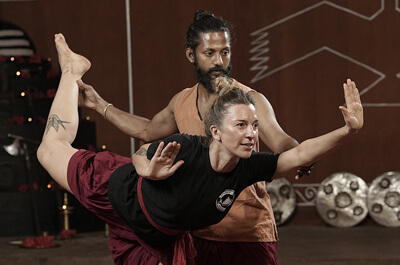Kalaripayattu, the ancient Indian martial art, is a rich tapestry of tradition, discipline and mastery. Practiced for centuries, it offers a holistic journey of self-discovery, physical conditioning and self-defense. Kalaripayattu is divided into distinct stages, each designed to build upon the foundation of the previous one. In this comprehensive guide, we’ll explore the stages of Kalaripayattu in detail.
Stage 1: Meithari
Meithari is the beginning of your journey in Kalaripayattu. It serves as the foundational stage, setting the groundwork for your martial path. Meithari is a dynamic stage encompassing various exercises, from mastering positions and jumps to practicing circular sequences, kicks, leg swings and an array of other movements.
Meithari is not solely about physical conditioning. It’s a stage that fosters discipline and mental focus. This initial phase instills the fundamental principles of balance, posture and flexibility. Agility, strength and a resilient mind are the cornerstones laid during Meithari, setting the stage for more advanced training.
Stage 2: Kolthari
As you progress in the Kalaripayattu journey, you enter Kolthari. This stage introduces the use of sticks in various forms – long, short, rounded, curved and more. In Kolthari, you master the art of wielding these sticks both offensively and defensively.
Kolthari training delves into the intricacies of stick-fighting, emphasizing precision, timing and leverage. You’ll become proficient in blocking, striking and countering with sticks, a valuable skill in self-defense. Kolthari takes you deeper into the world of combat techniques and timing.
Stage 3: Angathari
Angathari marks a significant shift in the Kalaripayattu journey as you venture into the realm of sharp and lethal metal weapons. This stage is a testament to the rich heritage of Indian weaponry, with students learning to handle spears, bows, daggers and more.
In Angathari, the focus shifts to weapon-based combat, where students explore the intricacies of both offense and defense. This stage requires precision and control, emphasizing the values of discipline and respect for the art. The training is a bridge between traditional weaponry and modern self-defense techniques.
Stage 4: Verumkai
Verumkai, the final stage of Kalaripayattu, is a true testament to your mastery of the martial art. It challenges you to face opponents, whether they are armed, unarmed, or in multiples, all without relying on weapons. Verumkai emphasizes the power of bare-handed combat techniques, including grips, kicks, strikes, blocks, attacks, throws and more.
In Verumkai, you push your physical and mental limits. This stage demands swift reflexes, acute awareness and adaptability to a diverse range of combat scenarios. It embodies the essence of Kalaripayattu, where your body becomes the ultimate weapon and your mind is your most potent shield.
Conclusion
In summary, Kalaripayattu is more than just a martial art; it’s a holistic journey of physical and mental growth. Each stage serves as a building block for the next, guiding you through foundational movements, stick-based techniques, mastery of weaponry and finally, the art of bare-handed combat. As you progress through these stages, you’ll uncover new layers of skill and self-discovery on your path to becoming a Kalaripayattu expert.
FAQs
Q: What is Kalaripayattu?
A: Kalaripayattu is an ancient Indian martial art form that combines physical conditioning, self-defense techniques and a rich cultural heritage.
Q: Is Kalaripayattu suitable for beginners?
A: Yes, Kalaripayattu welcomes beginners. Meithari, the first stage, is designed for newcomers and serves as a foundational step for all participants.
Q: Is Kalaripayattu only about fighting with weapons?
A: No, Kalaripayattu covers a wide range of skills, from bare-handed combat in Verumkai to using sticks and metal weapons in the Kolthari and Angathari stages.
Q: Is Kalaripayattu only for self-defense, or can I compete in tournaments?
A: Kalaripayattu mainly concentrates on self-defense and personal growth, but it also features in competitive events and demonstrations that highlight the art’s techniques and aesthetic appeal.
Q: Do I need prior martial arts experience to learn Kalaripayattu?
A: No prior experience is required. Kalaripayattu is open to individuals of all backgrounds and fitness levels.
Q: Is Kalaripayattu more than just a martial art?
A: Absolutely. Kalaripayattu is a holistic journey of self-discovery, discipline and overall growth, extending beyond combat skills.






Sir pls aap ke gurukul mein me bhi traning lena chata ho
Jaroor. Aap poora details is page mein jaan sakte hain: https://athmakalari.com/kalaripayattu-training/residential-kalari-programs